Cooking

Cooking, also known as cookery or professionally as the culinary arts, is the art,
Types of cooking also depend on the skill levels and training of the cooks. Cooking is done both by people in their own dwellings and by professional cooks and chefs in restaurants and other food establishments.
Preparing food with heat or fire is an activity unique to humans. Archeological evidence of cooking fires from at least 300,000 years ago exists, but some estimate that humans started cooking up to 2 million years ago.[1][2]
The expansion of agriculture, commerce, trade, and transportation between civilizations in different regions offered cooks many new ingredients. New inventions and technologies, such as the invention of pottery for holding and boiling of water, expanded cooking techniques. Some modern cooks apply advanced scientific techniques to food preparation to further enhance the flavor of the dish served.[3]
History
Phylogenetic analysis suggests that early hominids may have adopted cooking 1 million to 2 million years ago.[4] Re-analysis of burnt bone fragments and plant ashes from the Wonderwerk Cave in South Africa has provided evidence supporting control of fire by early humans by 1 million years ago.[5] In his seminal work Catching Fire: How Cooking Made Us Human, Richard Wrangham suggested that evolution of bipedalism and a large cranial capacity meant that early Homo habilis regularly cooked food.[6][7] However, unequivocal evidence in the archaeological record for the controlled use of fire begins at 400,000 BCE, long after Homo erectus.[8][9][clarification needed] Archaeological evidence from 300,000 years ago,[10] in the form of ancient hearths, earth ovens, burnt animal bones, and flint, are found across Europe and the Middle East. The oldest evidence (via heated fish teeth from a deep cave) of controlled use of fire to cook food by archaic humans was dated to ~780,000 years ago.[11][12] Anthropologists think that widespread cooking fires began about 250,000 years ago when hearths first appeared.[13]
Recently, the earliest hearths have been reported to be at least 790,000 years old.[14]
Communication between the
In the 17th and 18th centuries, food was a classic marker of identity in Europe. In the 19th-century "Age of Nationalism", cuisine became a defining symbol of national identity.[citation needed]
The
Ingredients
Most ingredients in cooking are derived from living
Naturally occurring ingredients contain various amounts of molecules called proteins, carbohydrates and fats. They also contain water and minerals. Cooking involves a manipulation of the chemical properties of these molecules.
Carbohydrates
Carbohydrates include the common sugar, sucrose (table sugar), a disaccharide, and such simple sugars as glucose (made by enzymatic splitting of sucrose) and fructose (from fruit), and starches from sources such as cereal flour, rice, arrowroot and potato.[17]
The interaction of heat and carbohydrate is complex.
An
Fats
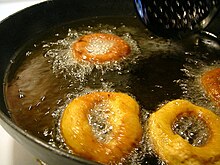
Types of fat include
Fats are one of the three main
Proteins
Edible animal material, including
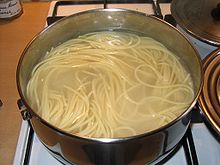
Water
Cooking often involves water, and water-based liquids. These can be added in order to immerse the substances being cooked (this is typically done with water,
Vitamins and minerals
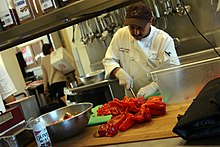
Vitamins and minerals are required for normal
Methods
There are many methods of cooking, most of which have been known since antiquity. These include baking, roasting, frying, grilling, barbecuing, smoking, boiling, steaming and braising. A more recent innovation is microwaving. Various methods use differing levels of heat and moisture and vary in cooking time. The method chosen greatly affects the result because some foods are more appropriate to some methods than others. Some major hot cooking techniques include:
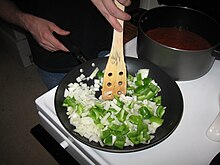
- Roasting
- Broiling – Rotisserie – Searing
- Baking
- Baking Blind
- Boiling
- Vacuum flask cooking
- Frying
- Hot sand frying – Pan frying – Pressure frying – Sautéing – Shallow frying – Stir frying – Vacuum frying
- Steaming
- Steaming works by boiling water continuously, causing it to vaporise into steam; the steam then carries heat to the nearby food, thus cooking the food. By many it is considered a healthy form of cooking, holding nutrients within the vegetable or meat being cooked.
- En papillote – The food is put into a pouch and then baked, allowing its own moisture to steam the food.
- Smoking
- Smoking is the process of flavoring, cooking, or preserving food by exposing it to smoke from burning or smoldering material, most often wood.
Health and safety
Indoor air pollution
As of 2021, over 2.6 billion people cook using open fires or inefficient stoves using
Security while cooking
Hazards while cooking can include
- Unseen slippery surfaces (such as from oil stains, water droplets, or items that have fallen on the floor)
- Cuts; about a third of the US's estimated annual 400,000 knife injuries are kitchen-related.[38]
- Burns or fires
To prevent those injuries there are protections such as cooking clothing, anti-slip shoes, fire extinguisher and more.
Food safety
Cooking can prevent many
The sterilizing effect of cooking depends on temperature, cooking time, and technique used. Some food spoilage bacteria such as Clostridium botulinum or Bacillus cereus can form spores that survive boiling, which then germinate and regrow after the food has cooled. This makes it unsafe to reheat cooked food more than once.[40]
Cooking increases the digestibility of many foods which are inedible or poisonous when raw. For example, raw cereal grains are hard to digest, while kidney beans are toxic when raw or improperly cooked due to the presence of phytohaemagglutinin, which is inactivated by cooking for at least ten minutes at 100 °C (212 °F).[41]
Food safety depends on the safe preparation, handling, and storage of food. Food spoilage bacteria proliferate in the "
Effects on nutritional content of food
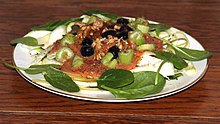
Proponents of raw foodism argue that cooking food increases the risk of some of the detrimental effects on food or health. They point out that during cooking of vegetables and fruit containing vitamin C, the vitamin elutes into the cooking water and becomes degraded through oxidation. Peeling vegetables can also substantially reduce the vitamin C content, especially in the case of potatoes where most vitamin C is in the skin.[46] However, research has shown that in the specific case of carotenoids a greater proportion is absorbed from cooked vegetables than from raw vegetables.[32]
Sulforaphane, a glucosinolate breakdown product, is present in vegetables such as broccoli, and is mostly destroyed when the vegetable is boiled.[47][48] Although there has been some basic research on how sulforaphane might exert beneficial effects in vivo, there is no high-quality evidence for its efficacy against human diseases.
The United States Department of Agriculture has studied retention data for 16 vitamins, 8 minerals, and alcohol for approximately 290 foods across various cooking methods.[49]
Carcinogens
In a human epidemiological analysis by Richard Doll and Richard Peto in 1981, diet was estimated to cause a large percentage of cancers.[50] Studies suggest that around 32% of cancer deaths may be avoidable by changes to the diet.[51] Some of these cancers may be caused by carcinogens in food generated during the cooking process, although it is often difficult to identify the specific components in diet that serve to increase cancer risk.[52]
Several studies published since 1990 indicate that cooking meat at high temperature creates
Baking, grilling or broiling food, especially starchy foods, until a toasted crust is formed generates significant concentrations of acrylamide. This discovery in 2002 led to international health concerns. Subsequent research has however found that it is not likely that the acrylamides in burnt or well-cooked food cause cancer in humans; Cancer Research UK categorizes the idea that burnt food causes cancer as a "myth".[55]
Scientific aspects
The scientific study of cooking has become known as molecular gastronomy. This is a subdiscipline of food science concerning the physical and chemical transformations that occur during cooking.[56]
Important contributions have been made by scientists, chefs and authors such as
Chemical processes central to cooking include hydrolysis (in particular beta elimination of pectins, during the thermal treatment of plant tissues), pyrolysis, and glycation reactions wrongly named
Cooking foods with heat depends on many factors: the
Home-cooking and commercial cooking

Home cooking has traditionally been a process carried out informally in a home or around a
"Home-cooking" may be associated with comfort food,[66] and some commercially produced foods and restaurant meals are presented through advertising or packaging as having been "home-cooked", regardless of their actual origin. This trend began in the 1920s and is attributed to people in urban areas of the U.S. wanting homestyle food even though their schedules and smaller kitchens made cooking harder.[67]
See also
- Carryover cooking
- Cookbook
- Cooker
- Cooking weights and measures
- Culinary arts
- Culinary profession
- Cooking school
- Dishwashing
- Food and cooking hygiene
- Food industry
- Food preservation
- Food writing
- Foodpairing
- Gourmet Museum and Library
- High altitude cooking
- International food terms
- List of cooking appliances
- List of cuisines
- List of films about cooking
- List of food preparation utensils
- List of ovens
- List of stoves
- Scented water
- Staple (cooking)
References
- ^ Rupp, Rebecca (2 September 2015). "A Brief History of Cooking With Fire". National Geographic. Archived from the original on 25 March 2019. Retrieved 29 May 2019.
- ^ Wrangham, Richard (2009). Catching Fire: How cooking made us human.
- PMID 21438483.
- PMID 21873223.
- ^ Pringle, Heather (2 April 2012), "Quest for Fire Began Earlier Than Thought", ScienceNOW, archived from the original on 15 April 2013, retrieved 4 April 2012
- ^ Wrangham, R. and Conklin-Brittain, N., 2003. Cooking as a biological trait. Comparative Biochemistry and Physiology Part A: Molecular & Integrative Physiology, 136(1), pp. 35–46
- ISBN 978-0-393-92207-3.
- ^ Luke, Kim. "Evidence That Human Ancestors Used Fire One Million Years Ago". Retrieved 27 October 2013.
An international team led by the University of Toronto and Hebrew University has identified the earliest known evidence of the use of fire by human ancestors. Microscopic traces of wood ash, alongside animal bones and stone tools, were found in a layer dated to one million years ago
- ^ "Archaeologists Find Earliest Evidence of Humans Cooking With Fire". DiscoverMagazine.com.
- ^ Smith, Roff (29 January 2014). "Oldest Known Hearth Found in Israel Cave". National Geographic. Archived from the original on 1 February 2014. Retrieved 17 March 2014.
- ^ "Ancient human relative used fire, surprising discoveries suggest". Washington Post. Retrieved 11 December 2022.
- S2CID 253522354.
- ^ "Pennisi: Did Cooked Tubers Spur the Evolution of Big Brains?". Cogweb.ucla.edu. Retrieved 7 November 2013.
- ^ "What Does It Mean To Be Human? – Hearths & Shelters". Smithsonian Institution. 12 August 2016. Retrieved 12 August 2016.
- JSTOR 25703506.
- ^ "The History of Food Irradiation" (PDF). Archived from the original (PDF) on 16 November 2013. Retrieved 27 March 2012.
- ^ "Carbohydrates: MedlinePlus Medical Encyclopedia". medlineplus.gov. Retrieved 4 February 2019.
- ISBN 978-1-4899-2628-9, retrieved 19 May 2021
- ^ "What is...roux?". MICHELIN Guide. Retrieved 4 February 2019.
- ^ Entry for "fat" "Archived copy". Archived from the original on 25 July 2020. Retrieved 8 December 2023.
{{cite web}}: CS1 maint: archived copy as title (link) CS1 maint: bot: original URL status unknown (link) in the online Merriam-Webster disctionary, sense 3.2. Accessed on 2020-08-09 - University of Illinois at Urbana–Champaign. Archived from the originalon 21 September 2014. Retrieved 20 September 2014.
- ^ "Introduction to Energy Storage". Khan Academy.
- PMID 35820048.
- ^ "Protein in diet". United States National Library of Medicine, National Institutes of Health. 2009.
- ^ "High-Protein Alternatives to Meat". Pocket. Retrieved 9 June 2022.
- ^ "cooking - Fun_with_Words - 博客园". www.cnblogs.com (in Chinese (China)). Retrieved 8 December 2023.
- ISSN 2772-5669.
- ISSN 2356-7481.
- ISBN 978-1-4438-4484-0.
- ^ "Loss of nutrients when vegetables are cooked". Archived from the original on 9 September 2009.
- ^ a b "Cooking vegetables 'improves benefits'". BBC News. 2 June 1999. Retrieved 30 April 2010.
- PMID 17374686.
- PMID 30263756.
- ^ "Household air pollution". www.who.int. Retrieved 8 December 2023.
- ^ "Polluting cooking methods, used by billions of people around the world, remain a threat to women's health". Equal Times. 16 January 2023. Retrieved 8 December 2023.
- ^ "Household air pollution and health". World Health Organization. 22 September 2021. Retrieved 12 April 2022.
- ^ "A Guide to Keeping Safe While Cooking". StaySafe.org. Retrieved 3 July 2021.
- ^ "Foodborne Illnesses". National Institute of Diabetes and Digestive and Kidney Diseases.
- ^ "Safe Food Australia – A Guide to the Food Safety Standards" (PDF). Archived from the original (PDF) on 22 September 2010.
- PMID 7407532.
- ^ "Grilling and Food Safety" (PDF). USDA. June 2017. Retrieved 30 January 2019.
- ^ "Basics for Handling Food Safely". United States Department of Agriculture. Archived from the original on 28 September 2004. Retrieved 1 April 2012.
- ^ "Cutting Boards (Plastic Versus Wood)". Food Safety, Preparation and Storage Tips. Cooperative Extension, College of Agriculture & Life Sciences, the University of Arizona. 1998. Archived from the original on 13 June 2006. Retrieved 21 June 2006.
- ^ a b "Cutting Boards – wood or plastic?". ReluctantGourmet.com. Archived from the original on 2 July 2006. Retrieved 21 June 2006.
- ^ "Potato, nutrition and diet – International Year of the Potato 2008". Archived from the original on 5 November 2007. Retrieved 14 August 2011.
- PMID 10552618.
- S2CID 35228794.
- ^ "USDA Table of Nutrient Retention Factors, Release 6" (PDF). USDA. USDA. December 2007. Archived (PDF) from the original on 9 October 2022.
- PMID 7017215.
- PMID 8741778.
- ^ ISBN 978-0-309-05391-4.
- ^ a b "Heterocyclic Amines in Cooked Meats". National Cancer Institute. 2018.
- PMID 6831466.
- ^ "Can eating burnt foods cause cancer?". Cancer Research UK. 15 October 2021.
- ^ Molecular Gastronomy Archived 19 October 2021 at the Wayback Machine from Encyclopedia Britannica
- ISBN 978-605-69709-1-7.
- ^ "Food-Info.net : Maillard reactions". www.food-info.net. Retrieved 29 March 2017.
- ^ Handbook of Molecular Gastronomy, CRC Press, 2021
- ^ Barham, Peter. The Science of Cooking. p. 39.
- ^ Jackson, Cecile (2013). Men at Work: Labour, Maculinities, Development. New York: Routledge. p. 225.
- ^ Lin, Biing-Hwan; Guthrie, Joanne. "Nutritional Quality of Food Prepared at Home and Away From Home, 1977–2008". www.ers.usda.gov. U.S. Department of Agriculture. Archived from the original on 22 November 2015. Retrieved 21 November 2015.
- PMID 24703245.
- S2CID 71797396.
- (PDF) from the original on 9 October 2022.
- ISBN 978-1-4968-1086-1.
- ]
External links
- Chisholm, Hugh, ed. (1911). . Encyclopædia Britannica. Vol. 7 (11th ed.). Cambridge University Press. pp. 74–76.
